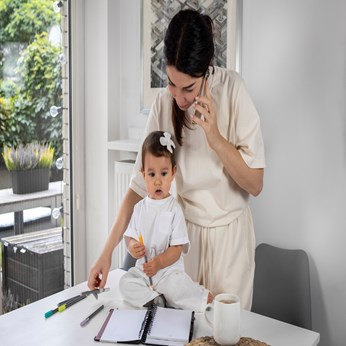Routine Checks To Be Made After Birth
Just after your baby is born the medical practitioner or midwife will carry out some routine tests to make sure all is well with the baby.
Here are some routine tests to ensure that all is well with the newborn:
The first important test is the Apgar score that is done 1 minute and 5 minutes after birth by the midwife by looking at the baby and assessing his/her skin color, breathing, heart rate, his/her movements and crying. You may find scores like 7/10 and 10/10 meaning that he scored 7/10 at birth and 10/10 at five minutes; if the birth and 5 minute score is lesser than 5 or 6 out of 10 a pediatrician may check your baby. If your baby needs some help, your midwife may either give him/her oxygen or clear out his airways to help him to breathe.
About an hour after birth when you have had sufficient time to cuddle the baby and have some skin-skin contact, the midwife would weigh the baby, check his/her temperature and measure the circumference of his head. These measurements would be entered in the personal child health record or red book as development charts. A full newborn examination is carried on within 72 hours of the baby’s birth giving the baby time to adjust to the outside world and allows for prompt medical attention. These measurements give an indication of how mature he/she is and serves as a starting point from which to measure his growth.
The midwife would make a head-to-toe examination to check for any problems and conditions. The doctor or midwife will look at the shape of your baby's head; a squashed or molded head that is very common in newborns could be caused by the baby being squeezed on his journey through the birth canal. It should be set right within 48 hours. Next the midwife will look at your baby’s eyes to check for any obvious problems by shining a light from an ophthalmoscope in your baby's eyes to look for a red reflex that rules out cataracts.

The doctor or midwife checks the root of his/her mouth and the sucking reflex. A gap in the palate also known as cleft palate may require surgery as it makes feeding difficult. The baby is also checked for tongue ties when the tongue remains anchored to the bottom of the mouth and restricts movement and causes persistent problems latching on to breastfeed.
The heart and lungs are also checked. The doctor or midwife listens to the heart beat through a stethoscope to exclude extra sounds or heart murmurs; these beats may be common in the first few days as your baby's pattern of circulation undergoes a major change once he is born. Heart murmurs however require a second opinion and further investigation in some cases. A further test for a heart condition is to feel for a pulse in your baby's groin or the femoral pulse. The lungs are also checked for effective functioning; you should hear clear, equal air entry into both of his lungs.
As a final note the doctor as I said will be checking all other parts of the body also to ensure your baby is healthy.
Image Courtesy: Google
Take the next step toward your goals
Share your requirement and find the best care providers in your area
-
Looking for a caretaker’s job? Build your profile and get in touch with families in your vicinity.
-
Discover nannies, babysitters, cooks, housekeepers, pet sitters, and elder care under one roof.
-
Get all the support you need to run a successful care center.
-
Search for appropriate centers near you depending on your needs.
Care Corner Insights: Blog Library

Daycare Admissions in Cary, NC for New NRI Families: Documents, Health Records, and Start Dates
Moving to a new country is exciting but also comes with many responsibilities—especially when it comes to finding the right daycare for your little one. For new NRI (Non-Resident Indian) families settling in Cary, NC, understanding the daycare

Overnight Babysitters in Bellevue, WA for Business-Travelling NRI Parents: Safety & Policies
For many NRI parents living in Bellevue, WA, frequent business trips are a reality. While traveling, one of the biggest concerns is ensuring your children are safe, cared for, and emotionally supported during overnight stays. Overnight babysitters ca

Indian Home-Style Cooks in Queens, NY: Tiffin-Style Weekly Meal Prep from Your Kitchen
Queens, NY, is home to one of the most diverse food cultures in the country, and Indian cuisine holds a special place among families looking for authentic, comforting meals. While restaurant takeout is convenient, nothing compares to the taste and nu

Baby Sleep Problems: What is Sleep Regression and How to Handle It
If you’re a parent, you know that baby sleep is one of the greatest mysteries of life. One day your little one is snoozing like an angel, and the next day they’re suddenly waking up every hour, fussing, or refusing to nap. Before you panic, there’s a

What is Validation Therapy? A New Approach to Dementia Care
Caring for loved ones with dementia is one of the most emotionally challenging journeys a family can face. Traditional methods often focus on correcting memory lapses or redirecting confused thoughts—but that can sometimes lead to frustration, stress

What is a Part-Time Nanny and Do You Need One
Parenting is a beautiful journey, but let’s be honest—it can also be exhausting! Between work deadlines, household chores, and family responsibilities, sometimes there just aren’t enough hours in a day. That’s where part-time nannies step in, offerin

Part-Time Housekeeper Hiring in Alpharetta, GA: Weekly Schedules, Pricing, and Must-Do Tasks
Keeping a home spotless while balancing work, family, and personal commitments can be overwhelming. For families and professionals in Alpharetta, GA, hiring a part-time housekeeper is one of the most practical solutions. Whether you need help once a

Affordable Daycares in Irving, TX with Indian Menu Options: Parent Reviews & Enrollment Tips
Finding the right daycare for your little one is never an easy decision—especially if you’re looking for one that fits your budget and offers familiar food options like an Indian-inspired menu. For parents in Irving, TX, the good news is that several

Can Babies Sleep on Their Side? Tips for Safe Baby Sleep
When it comes to newborns, every parent worries about the smallest details—how they sleep, what they wear, even which way they turn their tiny heads. One common question that pops up is: “Can babies sleep on their side?” The short answer? Not recom

8 Benefits of Hiring a House Cleaner for Your Home
Let’s be honest — keeping a home sparkling clean while juggling work, family, and daily life can feel like a full-time job in itself. That’s where professional house cleaners step in, turning the chaos into calm. If you’ve been debating whether to br